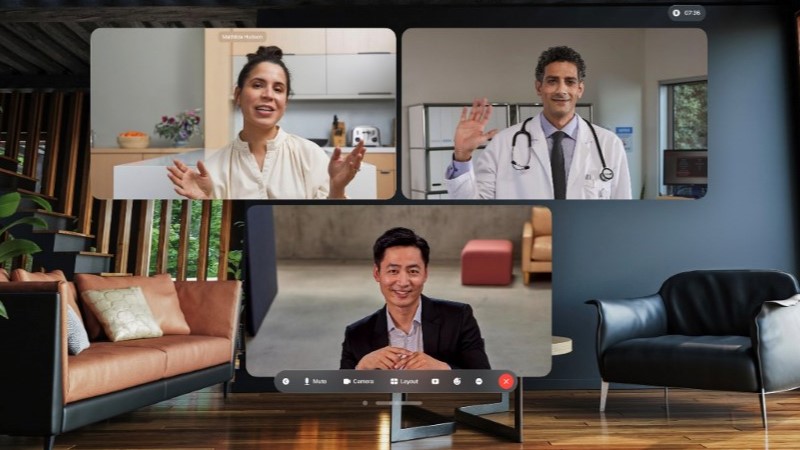This is a guest post by Leader and Top Customer Storyteller Christine Johansen.
Business leaders everywhere are evaluating technologies to take hybrid work to the next level, and GlobalLogic’s CIO Sunny Azadeh is no exception. She has a unique perspective on the challenges of hybrid work: She joined GlobalLogic just three months before the pandemic started. Four of her key team members joined during the pandemic. Then GlobalLogic acquired a company and onboarded 6,000 employees. And then Hitachi acquired them. That’s a lot of change under extremely challenging circumstances.
What are Azadeh’s top takeaways from 2020/2021? And what’s on her mind as 2022 unfolds? As part of our ongoing hybrid work series, we sat down with this Cisco customer (over Webex of course) to find out.
Q: First, what does GlobalLogic do?
A: GlobalLogic has been advising, designing, and building amazing software and digital products for over 20 years. Over 90% of our employees are engaged in delivering the software and digital products to our customers.
Q: Tell me a little about your experience during the height of the pandemic.
A: Personally, I joined three months before the pandemic. Four of my key team members joined during the pandemic. During that time, not only did we acquire a UK-based company, but Hitachi acquired us, too. We onboarded 6,000 employees during the pandemic—including our Chief Revenue Officer and Chief Legal Officer. We also started on our IT transformation across 5 different time zones with major programs requiring broad participation with no advantage of having people on-site during requirements gathering and conference room pilots. An added twist of having families all being at home, my daughter was doing her bar exam while my son was attending his on-line classes, and my meetings starting at 5am. At one point my son wanted to go to a hotel or Airbnb so he could sleep. In many ways, 2020 and 2021 seem like one very long, very fast-paced year! There were some tense moments for sure.
Q: Wow! That’s a lot. What was it like?
A: Many of our environments—both our customers as well as our own—were designed for the physical office. When the pandemic started, we had to quickly move from supporting seven development centers to 17,000 individual home offices. We are now up to supporting 23,000 when you add those 6,000 people who onboarded during the pandemic.
With our vendors including Cisco, we uplifted our infrastructure and heightened our cybersecurity. We executed our business continuity plans quite beautifully. We were able to secure laptops and devices and move the labs so we could start remote work.
Since then, remote work and now hybrid work has been a mixed bag for us. Some good, some challenging.
Q: It’s a new year, so let’s be optimistic and start with the good!
A: Ok—from a talent perspective, hybrid work has been a big win. Everyone enjoys the time savings of having no commute. Plus, you can hire talent anywhere. I've hired three people during the pandemic in North America, and they're not located near the headquarters. In IT we hire talent anywhere regardless of the office location globally. This enables us to bring the best talent onboard and not compete with local markets where the same talent is in high demand.
Q: OK so now for the rest of the “mixed bag”. What has been challenging?
A: There are many challenges for sure. The ones I am most focused on right now involve remote recruiting, onboarding, and career development; collaboration; and connectivity.
Q: Let’s go through each one. First up: remote onboarding, recruiting and career development.
A: The pandemic has shown us that remote onboarding has its challenges. The IT part of it is pretty much solved; we auto provision laptops remotely and manage security patches remotely. But the people side of things, connecting them to the company culture and welcoming them properly into the company—that’s different.
Developing a sense of belonging has traditionally happened at the physical site. So now we have work to do to make new employees feel a sense of belonging when they are onboarding over Webex.
If we back it up a step, we see we have some of the same challenges as we get and keep candidates engaged throughout the recruiting cycle and hiring process. How do we maintain the personal connection, when they aren’t coming to a company location to meet potential teammates? It’s time to rethink this too. And then if you fast-forward, you see you have similar challenges as the employee progresses in his or her career. Career development, coaching mentoring—the whole workforce management needs to be thought through outside of the ERP mindset from my perspective. You need a system of engagement with people and a career path that is visualized for them. You need to have learning paths that are not traditional learning paths and have a buddy system for people that are coming on board. If we help them be more successful, we’ll be more successful. There is an opportunity to think this through from a technology perspective—it’s part HR support, part employee communication, part technology. It’s a great opportunity to solve.
Q: I am guessing collaboration isn’t just one issue, right? It’s multifaceted.
A: Definitely. We’re keenly interested in solving for some of the big challenges we’ve seen unfold over the past months: for instance, how do you prevent video conference fatigue? We operate in Central Europe and India, we have offices in Germany, acquired a company in the UK. And now with the Hitachi acquisition, we have a completely different time zone in Japan. So, I can personally speak to the video conferencing fatigue. There are more meetings than ever; a lot of what happened as side conversations in the hallway are now happening in a meeting. From the people side of this, we are keenly aware that we need to nurture remote water cooler type of engagement—getting people interacting as if they are in the office when they aren’t in the office. I think it's key.
We are taking a fresh look at how we conduct meetings in the first place. Is there an optimal size or structure? How do you use video in a useful way when there are 60 people across five time zones in the virtual meeting room? What should change when half are on site and half are virtual?
To make matters more challenging, what happens when many of these people have no history with each other—when they have never broken bread together? What can we do about language barriers? As you can see, we are looking well beyond the basic file sharing and video conferencing and white boarding.
I just held our IT Summits with cross functional leadership present from both India and the Ukraine. Of the 50 attendees, a little more than half, myself included, were onsite. The rest were on a four-hour video call. It was so good to have that onsite conversation. We talked and bonded and focused on priorities and how we can scale the company together. It was wonderful. But the experience wasn’t quite as great for the remote participants. We are going to have to do better. The discussion onsite was so lively that the remote people didn't even get a chance to participate. The most interesting part was that we had very specific topics—it wasn’t like an overall “what should we do with our IT strategy and roadmap” brainstorm. It was very key initiatives, so you’d think it might be easier to get and keep everyone engaged.
We are also looking at very specific points in time when historically we’d all get in the same conference room for major projects—at the initiation, in the middle and at the end of major projects for instance. How can we do that effectively when we can’t plan on being able to travel? The variants are showing us that hybrid work is going to be a way of life, so we need to think through these things.
Q: Are there specific technologies you are investigating?
A: We are looking into what role various technologies can and should play—things like holograms, whiteboards, translations, meeting notes, and polling tools.
Q: Tell me about the next iteration of your infrastructure to support hybrid work.
A: We are always trying to make it simpler, in terms of the firewall structure in terms of active directory architecture in the cloud. I am looking at how we can secure 17,000 locations in a simpler manner. One of the things that is still a challenge is the connectivity; what your connectivity is like is highly dependent on where you live and who your service provider is. Our IT team can't go to people's homes and say, “okay, let me secure your Internet and parse it so all your devices, like dishwashers and smart laundry machines and fridges and TV and Alexa will go here, and this segment will be your work environment.” So, we are looking to ramp up security even more. We must monitor continuously at multiple levels to make sure that that the company’s reputation, assets, and people are safe. Ideally, we’d like to get to a point where employees pick up their secure box and they have their wide area network, LAN, and firewall—it goes with them wherever they go. We are looking to do this at global scale.
Q: Any advice for readers who are tackling issues like the ones we discussed today?
A: I think it’s important to keep focused on the fact that no company, unless you're talking about maybe a manufacturing facility, will ever go back to 100 percent on site. It’s clear that hybrid work is the future of work. The next phase of hybrid work will require a lot of innovation around remote collaboration, remote networks, Internet-to-go, and layers of cloud security--securing the endpoint, the email, the user’s identity.
Here at GlobalLogic, we’re brainstorming together with the CIO of Hitachi Japan on what exactly our new workplace will need. And we’re brainstorming with key vendors like Cisco, too, to define what the future will look like. It’s a huge responsibility as well as a huge opportunity to completely change the way we work, for the better.
###


